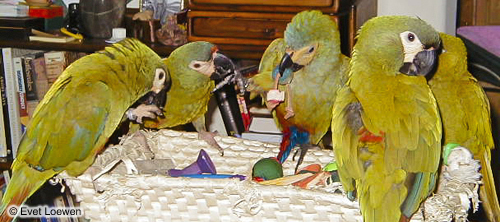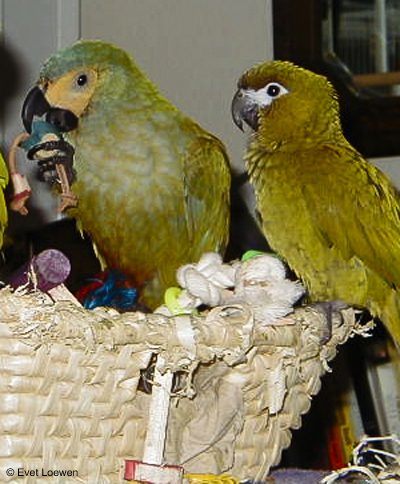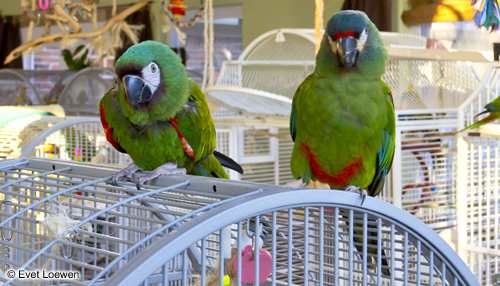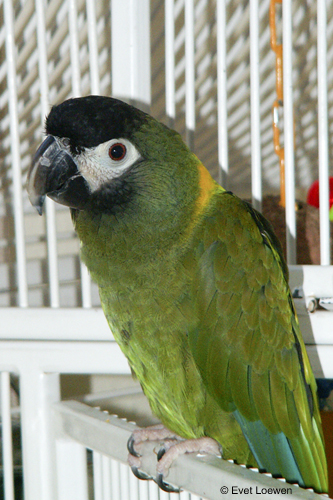By June and July of 2000, my efforts went into somehow integrating Sophia into a complicated multi-species flock. Looking back on the natural proclivities of Red Bellied Macaws, and the other mini-macaws in my flock at that time, it only dawns upon me now what difficult a task that would naturally be.
I've never studied or even seen Orthopsittica manilatas in the wild. The only observation that I can make about them in the wild is from videos and photos on the web. What I've seen rarely shows only one Red Bellied Macaw. There are typically at least three or four or a flock of twenty of their own kind. Perhaps it is just what the photographers and videographers were focused on, but as an amateur photographer myself[1], the mantra is "why photograph one bird if two to twenty can be photographed together?" It is only a hunch but it seems to me that this species is intensely flock-oriented and doesn't generally desire to casually associate with other species.
.jpg)
Sophia (aka "Jack") at play
I would not characterize Illiger's as overly-aggressive birds -- they are a very good-natured species overall. They will, however, kinda hang out in gangs if they find it convenient and be territorial, and it is not like there was a lot of territory to hang on to inside my residence. Dr. Van Sant used to refer in jest to three of my Blue-Winged macaws as "the thugs" because of their joint swaggering manner towards other birds. In general, though, the Illiger's mini-macaws have a really extroverted and playful temperament.

Sophia (aka "Jack") playing with gang of Illiger's and one Hahn's)

Sophia and Hahn's "Michie"
My Severe macaw, on the other hand, is a different story. She can be very high strung but her manner of high-strungedness is to try to put other birds on the defensive. To chase them out of whatever perches they thought they had. Frankly, it would take a gang of Illiger's to deal with Pepper.

Pepper with Overseer Illiger
My solo Yellow-Collar macaw has generally, not always, been a playful, sweet bird who avoids conflict in whatever way possible, unless there's a food fight. Even then, foraging on the floor of the aviary room seems to have become his way of avoiding squabbles over higher roosts (perhaps they go to ground a lot in the wild?).

Potter as a young bird with feathers
Over time with Sophia, my perception became that the Red Bellied Macaw temperament was distinctive. They are easily stressed by confrontation, and avoid it.
Sophia was an independent bird, to be certain. She did not want to step up on a hand or a stick, and I found ultimately that attempting to train her to do so was uncomfortable for both of us. She had a neat manner of avoiding conflicts over moving her from one place to another, however. She would fly from one location to another if I simply gestured where I wanted her to be. I never formally trained her to do this (I have no training as to how to train birds, so I spend my time being trained by them instead of the reverse).
For example, the flock had day cages on the first floor of my residence and smaller nighttime cages on the second floor. Sophia quickly learned that she could simply exit her nighttime cage and fly to her daytime cage and place herself in it, without having to deal with a request to step-up on sticks or hands. She would simply reverse this routine in the evening. None of my other flock members have ever been that cooperative.[2]
Similarly, if it was desirable for her to be on a particular stand or perch, I could ask her to go there by pointing and touching the location, and she would respond.
Since this occurred without positive reinforcement training, I came to regard it as being a cooperative way to maintain choice and dignity. She was, after all, truly a wild bird.
She readily participated in chewing on toys and going through baskets to find items she enjoyed while in the presence of others of my flock -- as long as I was around to play "tot lot referee" with the crew, so to speak. Flock companionship was important to her.
She differed not only in appearance and in her means of participation, though. She avoided territorial and food aggressiveness, would separate herself quickly from any competition, and would never go on the offensive just for the heckuvit. Sometimes, my Red Bellied Macaws have not seemed adamant enough about their space, frankly.
Sophia, however, would show her mettle in a very clear biological manner after only a very few months of living with me. After all, my motto always was "A thing worth doing is worth overdoing." I had not stopped looking for other Red Bellied Macaws. I found some.
Next up in Part 8: Young Red Bellied Macaws Join the Flock
----------
[1] My photos DO get better as these Chronicles move along. No kidding. Just you wait.
[2] There will be no "mea culpas" or apologies for the fact that small green birds boss me around. Just deal with it.
































